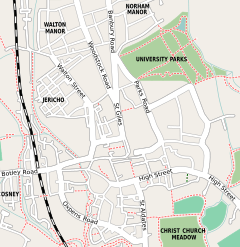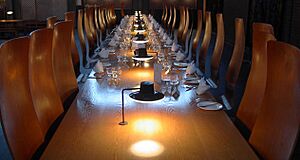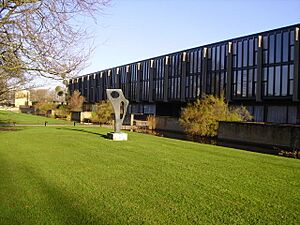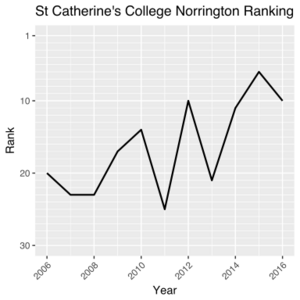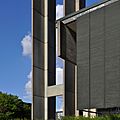St Catherine's College, Oxford facts for kids
Quick facts for kids St Catherine's College |
||||||||||||||||
|---|---|---|---|---|---|---|---|---|---|---|---|---|---|---|---|---|
 |
||||||||||||||||
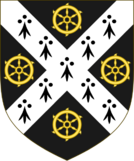
Blazon: Sable a saltire ermine between four catherine wheels or.
|
||||||||||||||||
|
|
||||||||||||||||
| University | University of Oxford | |||||||||||||||
| Location | Manor Road | |||||||||||||||
| Coordinates | 51°45′25″N 1°14′42″W / 51.757066°N 1.245098°W | |||||||||||||||
| Motto | Nova et Vetera (The New and the Old) | |||||||||||||||
| Established | 1868 and 1962 | |||||||||||||||
| Named after | Catherine of Alexandria | |||||||||||||||
| Previous names | Delegacy of Unattached Students, Delegacy of Non-Collegiate Students, St Catharine's Club, St Catherine's Society | |||||||||||||||
| Architect | Arne Jacobsen | |||||||||||||||
| Sister college | Robinson College, Cambridge | |||||||||||||||
| Master | Kersti Börjars | |||||||||||||||
| Undergraduates | 528 (December 2021) | |||||||||||||||
| Postgraduates | 385 (December 2021) | |||||||||||||||
| Map | ||||||||||||||||
St Catherine's College (often called St Catz or Catz) is a college at the University of Oxford in England. It was one of the first colleges for men to also welcome women in 1974. With many students, it is one of the largest colleges in Oxford or Cambridge.
The college was designed by the Danish architect Arne Jacobsen. He created a modern style that allowed more students to study at Oxford, especially those who didn't have a lot of money. In 2023, some parts of the college were closed for safety. This was because of a special type of concrete used in the buildings.
St Catherine's College grew from the university's St Catherine's Society. It became a full college in 1962. This happened thanks to the historian Alan Bullock, who became its first head, called the Master. The current Master is Kersti Börjars. She started in 2020 and is the college's first female Master.
Contents
College History: From Society to College
St Catherine's College started a long time ago, in 1868. Back then, it was a group for students who weren't part of a college. It was called the "Delegacy for Unattached Students." This group was created so that more students, especially those with less money, could study at Oxford. They could get an Oxford education without the high costs of joining a college.
The group quickly grew. By 1872, 330 students had joined. By 1914, over 4,000 men had studied as "non-collegiate" students. In 1884, the group changed its name to the "Delegacy for Non-Collegiate Students."
At first, the students had a room and a small library in the Old Clarendon Building. But they soon needed more space. In 1888, they moved to a bigger building on High Street. Here, they had a proper library and lecture halls. This building is now the Ruskin School of Art. In 1936, they moved again to buildings on St Aldates. These are now part of Oxford University's Faculty of Music.
By 1956, the society was very much like a college. So, they decided to become a full college. They bought land and raised a lot of money. The college officially opened in 1962. In 1974, St Catherine's was one of the first men's colleges to welcome women as full members.
The college celebrated its 150th birthday in 2018–2019. This included the 2018 Ball, called 'Continuum'. The 50th birthday of the college becoming a college was in 2012.
How St Catherine's Got Its Name
In 1931, the group officially became "St Catherine's Society." Students had already been using names like "St Catharine's" for their sports teams since the 1870s. So, the name was already well-known.
The students first formed a club in 1869 called the "Clarendon University Club." Later, in 1874, they started a bigger group called the St Catharine's Club. This was named after their meeting place, St Catharine's Hall. This hall was once a chapel built around 1520, known as St Catherine's Chapel. Even though it was no longer a chapel, the name "St Catharine's" stuck. The street nearby was also sometimes called Catherine Street, which helped link the college to the name.
Because of this, the college became linked to Catherine of Alexandria, a saint. Even though the connection was accidental at first, the college now celebrates St Catherine. They have a special "Catz Night dinner" where a giant Catherine wheel is lit. The college's shield also shows four Catherine wheels, which are symbols of St Catherine.
College Buildings and Design
St Catherine's College is in eastern Oxford, by the River Cherwell. Its buildings are made of glass, brick, and concrete. They were designed by the Danish architect Arne Jacobsen. He combined modern materials with the traditional Oxford college style, which has buildings around a central courtyard, called a quadrangle. Jacobsen designed everything, from the furniture and cutlery to the lamps and even the types of fish for the pond!
The original buildings at St Catherine's are famous for their modern design. An expert called Nikolaus Pevsner said they were "a perfect piece of architecture." Jacobsen himself thought it was his favorite work. These buildings are so special that they were given a Grade I listing in 1993. In 2020, the college gardens, also designed by Jacobsen, got the highest protection for their history and design.
Jacobsen's plans did not include a chapel, which is unusual for an Oxford college. For a while, St Cross Church was used for this purpose. Now, the college's Christmas carol concert is held in Harris Manchester College's chapel. The college has a bell tower. No college building is taller than three floors.
St Catherine's has many lecture halls and study rooms. It also has a music house, computer rooms, a small gym, and squash courts. There's a place for punts (small boats) and a Grade I listed bike shed. The common rooms for students are very spacious. The dining hall can seat 350 people, making it the largest in any Oxford college.
The college library has over 55,000 books. It is mainly used by students for their studies. There are also computer terminals. Law students have their own special library. Most teaching happens in the college. The college is also close to other university libraries that students can use.
Most of St Catherine's buildings are staircases that open onto the quads. These buildings have student rooms and offices. The college has a simple, modern look. Student rooms are bright and large, with big windows. In 2021, the college's buildings were named among the 90 most important UK buildings from the last 90 years.
Safety Concerns with RAAC Concrete
In September 2023, safety checks found that some college buildings contained a material called reinforced autoclaved aerated concrete (RAAC). Because of this, several shared spaces like the Junior Common Room, the Hall, kitchens, and the library had to be closed temporarily for safety.
New Buildings and Extensions
The college has grown over the years. In 1983, Knud Holscher, who worked with Jacobsen, added new parts. Later, Stephen Hodder added more buildings in two stages, from 1994 to 1995 and from 2002 to 2005. These new buildings created a second quad called 'New Quad'. This area is mostly used for second-year students.
In 2017, Purcell Architects got permission to build even more. They wanted the new buildings to look like Jacobsen's original designs. Construction started in 2018 and finished in 2019. This new area, called the Ainsworth Graduate Centre, opened in 2020. It has study rooms and spaces for graduate students. It also added 78 new student rooms with their own bathrooms.
Student Life at St Catz
St Catherine's welcomes many undergraduate and graduate students. The college has a bar, a Junior Common Room (JCR) for undergraduate students, and a Middle Common Room (MCR) for graduate students.
The JCR is run by a committee of 25 students. They organize events like Freshers' Week and help support students. They have meetings to discuss how to make the JCR better. All undergraduate students are automatically members. The MCR is for graduate students and some older undergraduate students. It is run by two co-presidents and organizes events like an annual garden party. The MCR also has its own kitchen and a private garden.
The college celebrates its patron saint, St Catherine, each year with a special dinner. Every three years, the college also holds a big ball. St Catherine's is known for its modern approach. For example, students usually don't have to wear gowns for dinners. They also voted to end the tradition of standing when the Master enters the hall, though many still do it out of respect. The college also has social events called 'Entz' and an annual 'Catz Artz Week' to show off creative talents.
The college has many facilities for sports, music, and other activities. These include squash courts, pool tables, a free gym, a punt house, and theatres. The music house has a grand piano. There are also many clubs and societies, like music groups, orchestras, choirs, and subject societies. The drama society puts on plays and musicals. St Catz has a friendly competition with Magdalen in sports.
Student Accommodation
The college can offer rooms for students for three years. All first-year students live on site. Most first and third-year students live in the 'Old Quad' (the original buildings). Second-year students live in the 'New Quad' (the newer buildings). There is a kitchen on every floor, usually shared by 8 to 10 people. In the Old Quad, bathrooms are shared by about 10 people. In the New Quad, every bedroom has its own bathroom. All rooms cost the same rent.
Academic Success
St Catherine's College has a strong academic record. In 2019, it was ranked 2nd in the Norrington Table. This table shows how well Oxford colleges perform in final exams. In 2018, the college was ranked 3rd, with about half of its students getting top marks. This was a big jump from 26th place in 2017.
Scholarships and Outreach Programs
The college offers many prizes and grants to students. These are given for academic success or for contributions to college life. For example, the Hart Prize is for the best history essay. The Thomas Jefferson Prize is for a North American student who has helped the college the most.
The college also gives out the Wallace Watson Scholarship. This is a very important scholarship for students doing research or traveling for their studies. Other awards include the Emilie Harris Award for helping communities and the Patricia Knapp Travel Award for medical travel.
St Catherine's also runs many free programs to help students apply to Oxford. The Catalyst Programme helps schools visit the college and offers workshops on applications. The Northern Ireland Residential Summer School lets students from Northern Ireland experience life at Oxford. The college also works with other programs like Target Oxbridge.
Rowing at St Catz
St Catherine's College Boat Club is the college's rowing club. Famous British Olympic gold medalists like Sir Matthew Pinsent and Andrew Triggs Hodge used to row for St Catz. Silver medalist Colin Smith also rowed for the college.
St Catz in Movies and TV
St Catherine's College has been used as a location for several films and TV shows.
- It was called 'Lovelace College' in Season 4 of the British crime show Endeavour.
- The spy drama Chokepoint was filmed around the college. The director said it was a good fit for the show's look.
- In Season 4, episode 6 of The Crown, the Hall at St Catherine's was used to look like a state reception in Hobart, Tasmania. This was for a scene about Prince Charles and Princess Diana's 1983 trip to Australia.
Notable Alumni
Many famous people have studied at St Catherine's College, including:
- Benazir Bhutto, who became the Prime Minister of Pakistan.
- J. Paul Getty, a famous oil businessman.
- Nobel Prize winners like John Cornforth, John Vane, and John E. Walker.
- Politicians like Peter Mandelson and Farooq Leghari.
College Leaders: Masters and Professors
The college has had several important leaders.
List of Masters
- 1962–1981: Alan Bullock; the first Master of the college.
- 2020–2024: Kersti Börjars; the current Master and the first woman to hold this role.
Cameron Mackintosh Visiting Professors
Since 1990, St Catherine's College has hosted famous people from the world of theatre. They are called the Cameron Mackintosh Visiting Professors. They give talks and workshops to students.
- 2023: Gregory Doran
- 2021: Adjoa Andoh
- 2017: Sir Tom Stoppard
- 2013: Stephen Fry
- 2008: Kevin Spacey
- 2006: Sir Patrick Stewart
- 1995: Arthur Miller
- 1991: Sir Ian McKellen
- 1990: Stephen Sondheim
Images for kids
-
The statue outside the old porter's lodge, "Achaean" by Barbara Hepworth.


